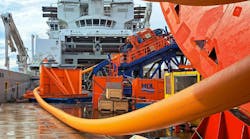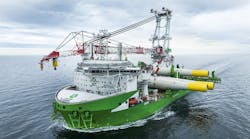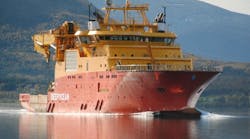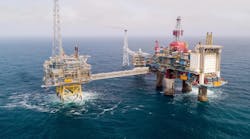Jeremy Beckman - Editor, Europe
Coastal Energy is laying the groundwork for two new oil production centers in the Gulf of Thailand. After initial difficulties with facilities installation due to storm damage, output is building steadily from Songhkla, the company’s first operated development in block G5/43. Platform installation and development drilling also should get under way shortly on Bua Ban, a second field to the west.
Both fields were discovered by a previous operator, but Coastal has since identified numerous other prospects in the block with prospective resources of several hundred million barrels. If further oil can be proven, the company aims to tie any future discoveries into its emerging infrastructure.
Houston-based Coastal – formerly PetroWorld – was established in 2004, and secured listings on investment markets in London and Toronto in 2005. The same year, PetroWorld farmed into block G5/43, recently awarded to private company NuCoastal Thailand, which also held a 12.6% interest in the onshore Phu Horn gas field in Thailand’s Khorat basin. Following a three-well appraisal program offshore on the Bua Ban field, a reverse merger between the partners led to the formation of a new entity, known as Coastal Energy Co.
According to the company’s chief financial officer, Bill Phelps, the original offshore discovery wells on block G5/43 were drilled in the late 1980s and early 1990s by Premier Oil Co. “We cannot speculate as to Premier’s rationale for not developing the fields, although we believe they were looking for much larger fields given the commodity prices environment at that time (mid-teens oil pricing).
“What Coastal has today in its Gulf of Thailand acreage is more akin to a ‘chain of pearls’ – numerous structures which may be 10-50 MMbbl recoverable. Altogether, we have identified 19 prospects on our licenses with a potential combined resource of 460 MMbbl.
“Our development strategy involves leveraging existing assets and services to more economically develop the additional appraisal and exploration targets by using shared services (FSO, support vessels, platforms, etc), thereby bringing down the opex per barrel. It should be noted that the shallow water depth of 20-30 m (65.6-98.4 ft) also facilitates lower opex and capex.”
Oligocene development
Block G5/43 covers an area of 8,500 sq km (3,282 sq mi) in the southwest of the Gulf of Thailand, in water depths below 25 m (82 ft). The block includes three discrete Tertiary half graben basins, the Songhkla, Nakhon, and Kho Kra basins (the latter two recently undergoing 2D seismic data acquisition). Collectively, the three basins contain up to 13,000 ft (3,962 m) of sedimentary section, and are characterized by early Tertiary rift phase, a period when lacustrine sediment systems predominated.
Prospective structures identified to date mainly are tilted fault traps or anti-form features connected with rollover into the basin margin faults. Structuring shows best development at Oligocene and older levels, ultimate top seal being provided by a late-Oligocene thick calcareous claystone.
The Songhkla basin in the southern part of the block has been the focus of activity since Premier drilled the first wells in the area in the late 1980s. During 1988-96, five exploration wells were drilled leading to four oil discoveries. Among these was the Songhkla Oligocene field, 15 mi (24 km) offshore in 78 ft (23.7 m) of water, which encountered 30º API oil in the Lower Oligocene formation. During tests of two sandstone sections, the well flowed at rates of 950-1,500 b/d from this formation, with a gas-oil ratio of 140 cf/bbl.
Late in 2008, Coastal drilled its first development wells, A-01 and A-03, into the same formation for its Songhkla Main project. These wells were flow tested with high volume downhole electric submersible pumps, which produced much higher rates (up to 5,100 b/d for A-1 and 4,000 b/d for A-3).
Around the same time, Coastal drilled the A-07 exploratory well into fault block A of the deeper Songhkla East Eocene prospect, a short distance east of the main Songhkla Oligocene field. This well proved the productivity of the Eocene reservoir, flowing at test rates of around 1,100 b/d of oil, but with the same amount in water production. Based on these results, independent consultants Huddleston have estimated the Songhkla Oligocene recoverable reserves in the range 9.38-19.6 MMbbl, and Songhkla East Eocene’s fault block A potential in the range 1.07-7.55 MMbbl.
Well construction issues
The early Songhkla development wells were drilled by theDeep Driller, a newbuild Baker Marine Pacific Class 375 jackup owned by Deep Drilling 7 Pte. The extended tests that followed were designed to provide data to optimize the full-scale development, which was due to get under way in earnest in early 2009. A-01 extended the main Oligocene pay zone seen in the original Songhkla-1 well, and revealed another pay zone in the Lower Oligocene. A-03, completed in the Lower Oligocene, also delivered improved net pay.
After performing remedial work on the A-07 Eocene well to isolate the water breakthrough, production was suspended while the rig was demobilized ahead of the arrival of a mobile offshore production unit. Unfortunately, the MOPU was damaged a tropical storm en route, causing a further delay until an alternate MOPU could be brought over in February 2009.
By mid-April, all three of the early wells were online, delivering around 10,000 b/d combined, helped by downhole electric submersible pumps, with production offloaded to a storage tanker. Output then fell back as water increased in each of the wells, in line with the performance of other fields in the region. However, Huddleston’s analysis suggested the rate of water production would not impact recovery from either the Lower Oligocene or Eocene reservoirs.
In mid-July 2009, Coastal engaged theAtwood Vicksburg jackup for the next phase of drilling, comprising two further Lower Oligocene oil producers (A-02 and A-04) and two water injectors to help re-pressurize the reservoir to maintain the field’s strong water drive.
During September-October, the rig drilled and completed A-02 and A-04, although sudden water inflow attributed to cement damage caused A-02 to be shut in. Eventually, this well was converted to a second water injector, with a replacement development well (A-08) drilled into the Lower Oligocene. A third water injector (A-06) was added shortly afterwards.
Later, A-04 also had to be shut in due to mechanical pump problems, limiting output from Songhkla A Main to 7,000 b/d from four producer wells. Coastal has mobilized a hydraulic workover unit to address the problem on A-04 and to install larger-capacity pumps at A-01 and A-03. Following the changes, the company expected to restore production to around 10,000 b/d by early February.
According to Phelps, the facilities on Songhkla Main provide total liquids production capacity of 30,000 b/d and 20,000 b/d of water injection capacity, which could be further upsized. All produced water is re-injected. The tanker can store around 300,000 bbl. The Songhkla crude has a high wax content, but there are no issues complicating processing, and no associated gas.
“The recent decline in servicing pricing has absolutely been beneficial,” Phelps points out. “It has brought our per-well cost down by more than 50% from 4Q 2008. The project’s economics are still very favorable at current commodity price levels. Our break-even price is closer to $25/bbl.” All the facilities are leased, he adds, incurring opex of around $100,000/day.
Eocene play
The company also hopes for further positives from potentially high-impact exploratory wells on the Songhkla B structure. TheAtwood Vicksburg recently drilled the first of these wells, B-01, encountering oil-bearing sands in Lower Oligocene, but with limited pay.
Prospective resources for all of Songhkla B are estimated at 106 MMbbl, divided between an eastern and western area. A successful discovery likely would be developed swiftly through a tieback to the MOPU. Further plans to appraise the Songhkla A Miocene have been deferred for the time being.
Following Songhkla B, the company will mobilize the rig to Benjarong Main, a Premier Oil discovery. That early well encountered 105 ft (32 m) of net pay in the Eocene; the Eocene formation was tight, but recovered oil via a repeat formation test. Coastal estimates the field’s contingent resources at 17.5 MMbbl, but the reserves classification would have to be confirmed by further drilling on the Eocene prospect.
After Benjarong, the rig’s next assignment will be development wells on Bua Ban. These will be drilled over a fixed platform, to be installed shortly by a heavy-lift barge under a contract with EMAS. Coastal has a 20-year production license for Bua Ban, covering an area of around 282 sq km (109 sq mi).
Bua Ban is in 60 ft (18.3 m) of water, 17 mi (27 km) north of the port of Songhkla and 10 mi (16 km) from the coast. Premier drilled a vertical well into the structure in 1990, finding and testing waxy crude from several Lower Oligocene sandstone intervals at rates ranging from 420-768 b/d. The three appraisal wells in 2005, Bua Ban 2, 2A, and 3A, helped define the productive limits of the main Oligocene reservoir. Two years later, Coastal acquired high resolution 3D seismic over the field and the surrounding area to finalize its detailed technical evaluation of the structure.
Bua Ban is a north-south elongated anticline extending over much of the southern half of block G5/43, with proven and probable reserves of around 21.8 MMbbl. Its Lower Oligocene formation appears to have been deposited as a lacustrine delta, with sediment entering the basin from the west, crossing the western boundary fault to the north of the Bua Ban structure and spreading oil out along the downthrown side of the fault system. Upper Oligocene lacustrine shale provides the regional seal.
Coastal plans to start production by late summer through temporary storage and offloading facilities, targeting 9,500 b/d of oil from Bua Ban by the end of 2010. Total capex for this project is estimated at $60-70 million.
The 2007 3D survey also revealed or delineated at least nine prospects which could be similar in size to Bua Ban. Five of the prospects are relatively close to Bua Ban, while the other three are nearer to Benjarong Main. Coastal’s high resource case for these prospects is 312 MMbbl.
Last fall, Coastal also acquired 4,000 km (2,485 mi) of 2D seismic data over the unexplored Ko Kra and Nakhon basins in the northern segment of block G5/43 and neighboring offshore block G5/50.
It aims to complete processing and interpretation by end-March. There is an obligation to drill one well in the area later this year under the concession agreement for block G5/50.
Coastal’s strategy is to continue expanding its portfolio in the Asia/Pacific region based on identifying further “orphaned” discoveries.
Phelps says the company has not evaluated any further assets in the Gulf of Thailand recently, but the company has conducted technical reviews in China, India, Indonesia, and Vietnam.







